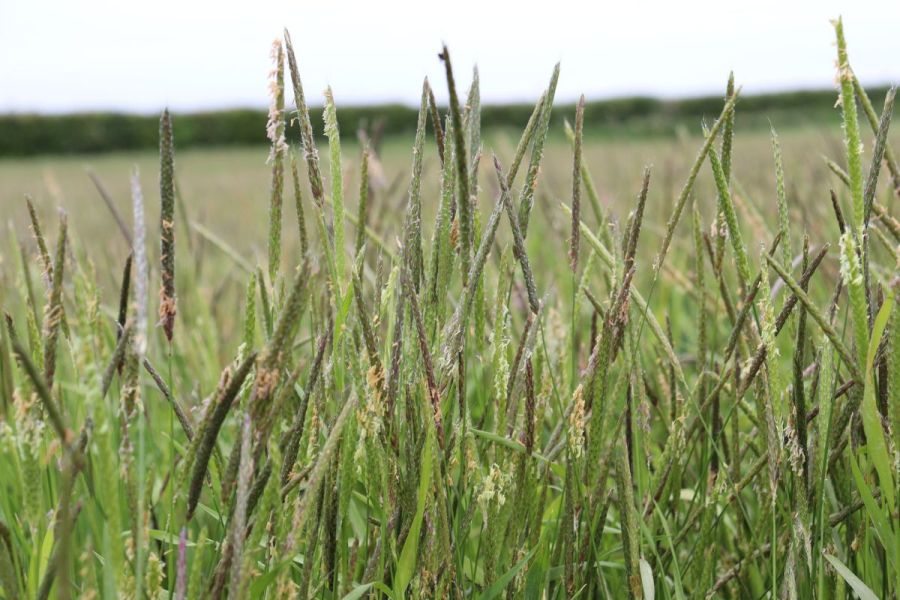Word in the field this season is grassweed pressure has caught some off-guard despite deploying a range of control methods. CPM draws on insight from growers to help unpick the reasons why and understand whether IPM is having a positive impact.
“This is only one season, don’t be tempted to give up on a planned and sustained approach to control.”
By Janine Adamson
Blackgrass, ryegrass and bromes – an unwelcome gang who’ve found themselves the topic of many conversations this season. The question is how to ensure their prompt departure while discouraging them from appearing again?

John Cussans says although there could be more spring germination than usual this year, autumn established weeds should remain the focus.
NIAB’s weed biology and management specialist, John Cussans, says despite taking all of the precautions, for some, the troublesome guests still turned up. “It’s been a tough year out there for grassweed control. Some growers have done all the right things yet still achieved the wrong outcome through no fault of their own. Of course, this could discourage them from sticking to the cause,” he says.
And John isn’t wrong – a recent grower survey conducted by CPM and BASF confirms that grassweeds appear to be a significant problem this season. Of those taking part, 57% have noted higher blackgrass pressure than last year, with 39% seeing an increase in bromes and 27% a rise in ryegrass. In fact, 36% said blackgrass pressure is much higher than last season.
“The challenge for many has been practical impediment – extreme weather when it’s counted the most plus rotational challenges. But it’s important to remember this is only one season, don’t be tempted to give up on a planned and sustained approach to control,” says John.
According to the survey, weed pressure has ramped up considerably during the past few months. At the time of data collection (June 2023), 58% of growers said blackgrass pressure was higher than they’d previously thought compared with the scenario in February. For bromes, 32% had noted higher pressure and for ryegrass, 20%.
BASF’s blackgrass expert Stuart Kevis says environmental conditions have given grassweeds a chance to thrive. “Discussions in December and January suggested growers were happy with their autumn weed control, but blackgrass won’t have been so easy to pick up back then.
“We experienced a dry February which gave those autumn ‘survivors’ a window of opportunity while the crop was struggling – we’ve heard reports of up to 110 tillers being found on a single blackgrass plant,” he says.
“And to top it off, a wet March prevented field travel so application of spring graminicides was missed. It’s simply a sequence of unfortunate conditions.”
Despite Stuart believing most of the current weed pressure is due to vigorous, surviving plants, 65% of those surveyed said they’d noticed an increase in spring germinating grassweeds this year.
John says although there could be more spring germination than usual, autumn-established weeds should remain the focus. “If you experience low germination in the autumn, of course more seed will be left in the spring. However, if you compare the size and seed return from an autumn versus a spring germinating weed in a winter-sown crop, it’s the autumn germinators that require most attention,” he says.
Although confirming a difficult season for grassweed pressure, more importantly, the survey highlighted a positive message – the consistent use of cultural control methods. This season, 56% said they’re roguing wheat crops, 57% are spraying off patches, 43% are mapping high pressure areas and 12% will be using resistance testing. The majority of participants said they’re using more than one technique, whereas just 9% said they don’t use any of those principles at all.
John says given the push for IPM, the data is encouraging to see, although there could be a greater uptake of resistance testing. “For an industry where we beat ourselves up about IPM, it’s a clear sign that for grassweed management at least, the consistent messaging is working and being understood by the people who matter.
“Next will be to encourage a greater understanding of herbicide resistance, which is vital in identifying which products are still effective, ready for when they’re required.”

According to Stuart Kevis, brome pressure can be linked to direct drilling which could be why some growers may have to hit the reset button and plough.
For Stuart, the uptake of weed mapping is a stand-out. “Mapping is an area which will continue to grow as a result of agri-tech innovation and product development. Yes, grassweed detection is difficult in a cereal crop, but sophisticated options are in the pipeline to support this grower interest,” he says.
Conversely, he warns of the ticking timebomb that’s labour for roguing. “Although more than half of those surveyed rogue crops, it’s important to acknowledge it’s becoming increasingly difficult to find manual labour. I should imagine some growers will have wanted to rogue but were unable to find the help,” he says.
The survey also asked about longer-term IPM practices and rotation management. Again, the message is positive – 74% of those surveyed used stale seedbeds this year, 72% utilised spring cropping, 70% delayed drilling, 43% used winter break crops and 31% made soil drainage improvements.
Despite the continued drive towards direct drilling and min-till, 54% used rotational ploughing and 62% believe they’ll have to use the tactic next year (2023/24).
According to John, a rotational plough ‘re-set’ remains a robust IPM technique in heavy grassweed scenarios. “Research has shown that infrequent ploughing is more efficient than frequent ploughing, especially the case if it hasn’t been used for a while in a particular field.
“Optimum inversion in the right conditions is the goal. You only have the opportunity to use this reset every now and then so it’s important to ensure it’s effective,” he says.
As for stale seedbeds, 78% intend to use the method this coming year, despite 40% of participants saying they were unsatisfied with the weed flush prior to drilling last autumn.
North Norfolk-based AICC agronomist, Craig Green, stresses the importance of a stale seedbed, even if this year it has proven unsuccessful. “Drilling date is critical for grassweed control with a sweet-spot of around 10 October. If you compare this with drilling at, say, 26 September, there’s a remarkable difference in plant count even when using the same chemistry stack.
“The earlier you drill, the more weeds you’ll encounter. If you delay but then can’t travel due to weather conditions, be prepared with a plan B such as spring barley,” he says.
Of course it’s not just blackgrass causing a headache, Stuart says the data backs up concerns regarding an increase in bromes too. “Brome pressure can be linked to direct drilling which has become more popular during recent years. This could be another reason why some may have to hit the reset button and plough.”
Overall, the survey shows that year-on-year, more growers are placing IPM at the heart of grassweed control strategies. This will become increasingly important given cultural controls are an integral part of the stewardship for new herbicide, Luxinum Plus (cinmethylin).
According to Stuart, a robust IPM approach gives the chemistry the greatest chance of being available for the longest time possible. “New modes of action aren’t frequent, so it’s important to look after what we do have through exercising best practice. This includes using combinations of different modes of action while maintaining optimum dose rates to hit grassweeds as hard as you can, as early as you can,” he says.

Be prepared with a plan B, such as spring barley, if weather prevents ground travel after delaying drilling, says Craig Green.
“This season has proven how vital that is by placing additional pressure on the chemistry in a scenario where there are already limited herbicide options. But remember, this is the weed flush during a very pressured year despite deploying control tactics. Imagine the scenario if nothing had been done at all.”
To conclude the survey, participants were asked if they’d tried Luximo/Luxinum Plus on winter wheat crops this year, with 51% confirming they had. As for this coming autumn, 64% said they’re likely to try it. Given this is a considerable uplift in just one year, John warns of the importance of resistance management.
“The survey shows a rapid uptake of a new product which means we must see an equally rapid uptake of the corresponding stewardship guidelines. This’ll protect the integrity of Luximo to ensure the high use among growers is sustainable long-term,” he says.
Craig says this is the same as the advice he’s already giving to growers. “Luximo isn’t a silver bullet – if you use it to control rampant blackgrass in a late September drilled wheat crop, you’ll be disappointed.
“However, benchmarked against a typical Liberator (flufenacet+ diflufenican) plus Crystal (flufenacet+ pendimethalin) mix with IPM techniques including optimum drilling date, you can achieve roguable levels of blackgrass where previously it was unmanageable.
“It isn’t faultless, but it offers solid blackgrass control with the added bonus of knocking ryegrass out too, both of which are problematic in my area,” he concludes.
This article was taken from the latest issue of CPM. Read the article in full here.
For more articles like this, subscribe here.
Sign up for Crop Production Magazine’s FREE e-newsletter here.




